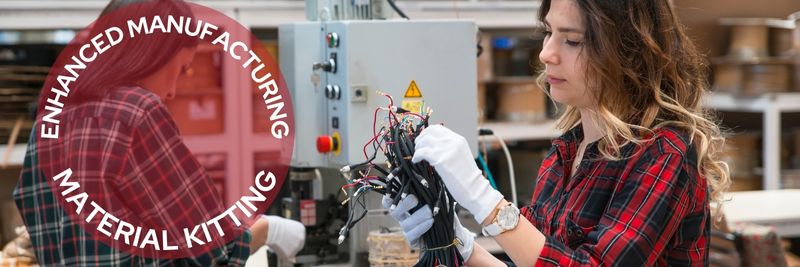
Efficiency in manufacturing relies on a reliable system of all components coming together at the right place at the right time. Material kitting plays a vital role in the process by organizing preassembled parts and raw materials into kits that are delivered directly to the production floor. This approach minimizes searching, reduces downtime, and ensures workers can focus on assembly rather than material handling.
By organizing components in advance, material kitting streamlines workflows, reduces errors, and supports just-in-time (JIT) manufacturing strategies. For companies seeking to improve output while maintaining accuracy and consistency, kitting in manufacturing is one of the most effective ways to strengthen the production floor.
Best Practices for Material Kitting on the Production Floor
Production efficiency begins with well-organized material flow, ensuring every component is where it should be at the right time. That level of coordination doesn’t happen by chance; it requires structured kitting processes designed to keep workers supplied without interruption. Material kitting organizes all the parts and subassemblies needed for a specific task into one kit, reducing the time employees spend searching for items and minimizing the risk of errors.
When appropriately implemented, kitting creates a smoother workflow on the production floor. Workers can stay focused on value-added tasks, production schedules remain on track, and assembly lines become less vulnerable to bottlenecks caused by misplaced or missing materials.
Research on assembly line performance highlights that efficiency depends heavily on reliable material supply. According to an IEOM Society study, production outcomes suffer when companies lack a structured material feeding system, while coordinated and precise delivery of components drives stronger operational results.
By treating kitting as a core part of the production model rather than a secondary process, manufacturers can improve both speed and accuracy, two critical drivers of competitiveness in modern manufacturing.
Stabilizing Assembly Work with Just-in-Time Kitting
Material kitting plays a vital role in stabilizing production environments by supporting just-in-time (JIT) delivery. Instead of operators spending time searching for individual components, kits arrive prepared and aligned with specific assembly tasks. This reduces downtime, improves workplace organization, and allows teams to focus directly on value-added work.
A study published in the ASCE Library found that material kitting can significantly improve workplace utilization and on-site productivity by ensuring components are delivered in sync with production schedules. However, the research also notes that the effectiveness of kitting depends on centralized material logistics, smooth information flow between departments, and strong collaboration with suppliers. These factors ensure kitting supports, not hinders, the broader production model.
When manufacturers integrate structured kitting systems on the production floor, they gain more than speed. Kitting combines multiple SKUs into a single kit, simplifying inventory tracking and creating smoother material flow across operations. This structured approach builds consistency, reduces variability, and enables higher utilization of both equipment and labor.
Value-Added Benefits of Material Kitting
Beyond reducing assembly delays, material kitting provides manufacturers with measurable value across the production floor. When operators work from prepared kits, errors decline, and quality improves. This structured approach also simplifies training for new employees, since they can immediately follow organized component groupings without needing deep familiarity with the complete parts catalog.
Manufacturers that integrate kitting into their production models often see:
- Higher productivity through reduced part-searching time.
- Improved quality control by eliminating missing or mismatched components.
- Lower inventory costs by aligning kit preparation with real production demand.
- Stronger collaboration between procurement, warehouse, and assembly teams.
These benefits reinforce why many facilities adopt professional kitting services as part of their lean manufacturing strategies. PPS’s kitting solutions are designed to support these objectives, offering reliable systems for both standard and specialized production needs.
Kitting for Manufacturing Applications
Kitting is especially effective in manufacturing settings where multiple parts and assemblies must be coordinated with precision. By staging components in advance, companies can streamline changeovers, keep assembly areas clear, and meet tighter production deadlines.
PPS manufacturing kitting solutions support a wide range of industries, helping clients achieve smoother production cycles without overloading operators. Kits can be organized to fit specific assembly tasks, high-mix product lines, or JIT delivery models, ensuring the right parts arrive at the right time no matter the production style.
Partnering With PPS for Kitting Services
For manufacturers seeking to reduce downtime, increase consistency, and maximize productivity, outsourcing kitting can be a strategic advantage. PPS offers comprehensive contract kitting services with modern equipment, automated handling capabilities, and scalable capacity to fit both small-batch and large-volume operations.
With decades of experience, PPS has the expertise to manage complex assemblies, package components with accuracy, and adapt to evolving production requirements. Our kitting solutions go beyond simply organizing materials; we integrate into the larger production workflow to ensure efficiency at every step, becoming a value-added supplier to many manufacturing supply chains.
Production efficiency begins with structured material flow, and material kitting provides the foundation for success. From reducing wasted motion to ensuring accurate labeling and greater task consistency, kitting strengthens control over both components and finished goods. Partnering with PPS gives manufacturers the added assurance of ISO 9001:2015 compliant processes, helping stabilize assembly work, manage inventory effectively, and achieve measurable performance gains.
PPS delivers high-quality material kitting solutions designed for manufacturing efficiency. We help clients improve productivity, reduce errors, and simplify assembly operations across industries. Contact us today to learn how our contract kitting services can support your production needs.
